Quantum speed limit for mixed states in a unitary system
2022-11-21JieHuiHuang黄接辉LiGuoQin秦立国GuangLongChen陈光龙LiYunHu胡利云andFuYaoLiu刘福窑
Jie-Hui Huang(黄接辉) Li-Guo Qin(秦立国) Guang-Long Chen(陈光龙)Li-Yun Hu(胡利云) and Fu-Yao Liu(刘福窑)
1School of Mathematics,Physics and Statistics,Shanghai University of Engineering Science,Shanghai 201620,China
2College of Physics and Communication Electronics,Jiangxi Normal University,Nanchang 330022,China
Since the evolution of a mixed state in a unitary system is equivalent to the joint evolution of the eigenvectors contained in it, we could use the tool of instantaneous angular velocity for pure states to study the quantum speed limit(QSL)of a mixed state. We derive a lower bound for the evolution time of a mixed state to a target state in a unitary system, which automatically reduces to the quantum speed limit induced by the Fubini–Study metric for pure states. The computation of the QSL of a degenerate mixed state is more complicated than that of a non-degenerate mixed state,where we have to make a singular value decomposition(SVD)on the inner product between the two eigenvector matrices of the initial and target states. By combing these results, a lower bound for the evolution time of a general mixed state is presented. In order to compare the tightness among the lower bound proposed here and lower bounds reported in the references,two examples in a single-qubit system and in a single-qutrit system are studied analytically and numerically, respectively. All conclusions derived in this work are independent of the eigenvalues of the mixed state,which is in accord with the evolution properties of a quantum unitary system.
Keywords: quantum speed limit,instantaneous angular velocity,singular value decomposition
1. Introduction
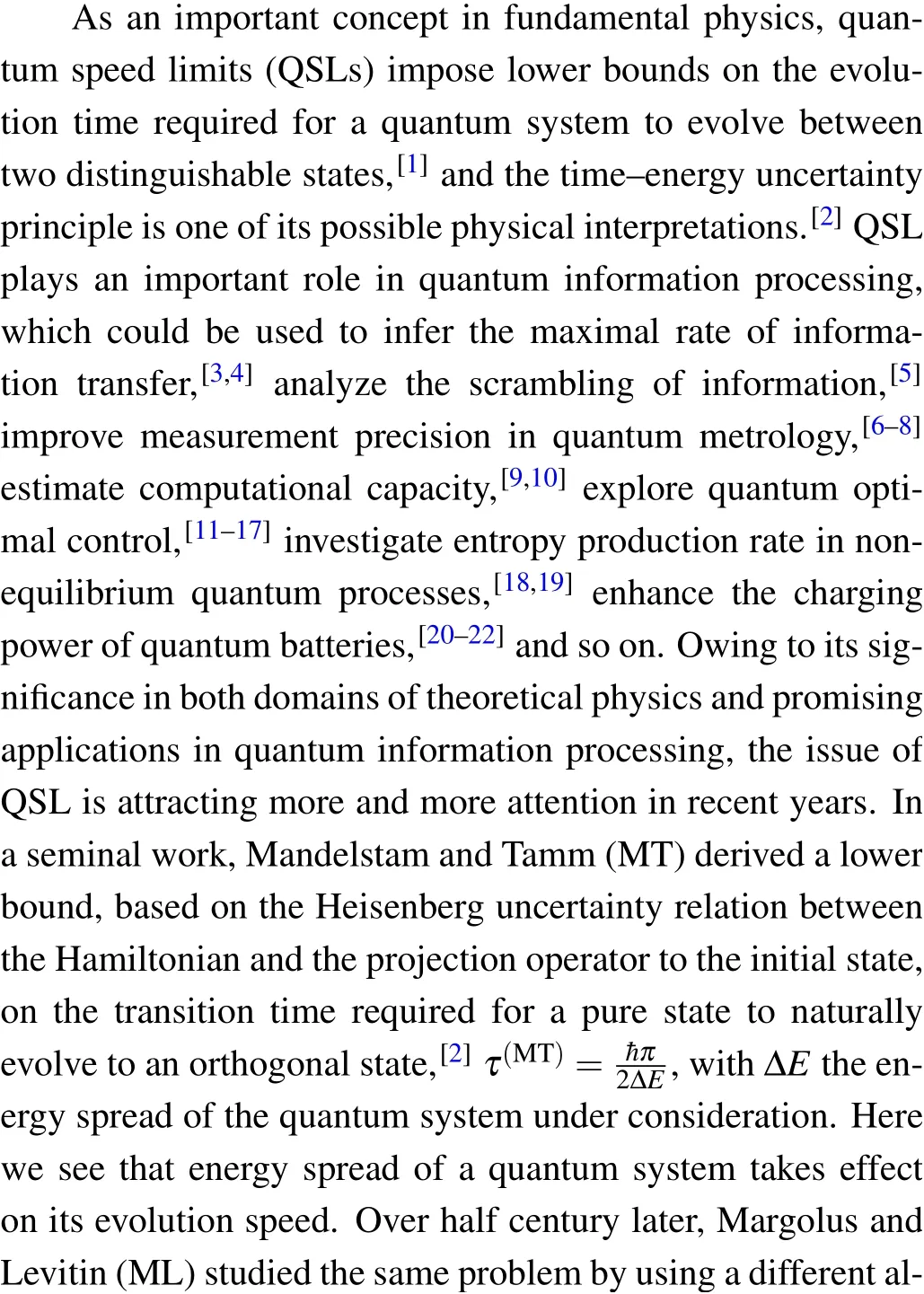
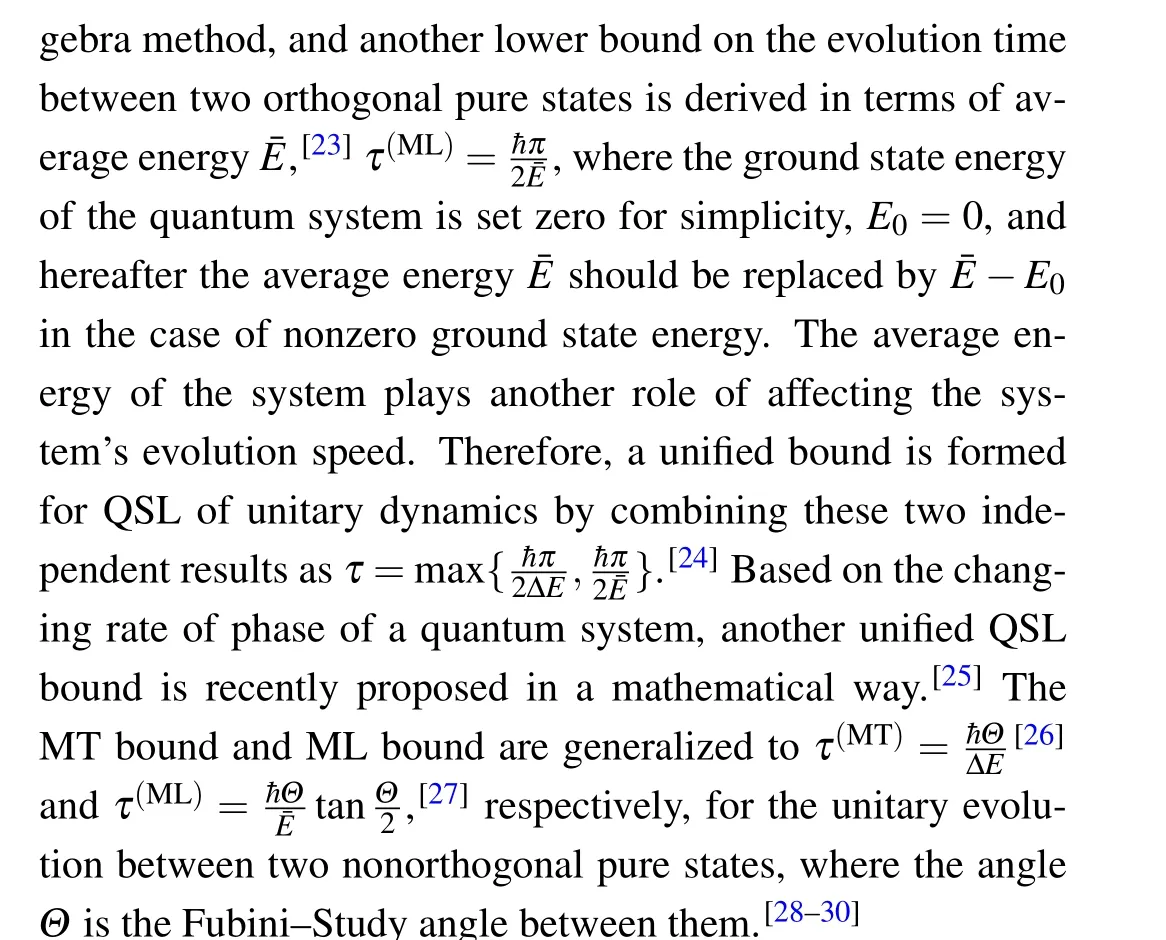
Based on the fact that the geodesic length between two distinguishable pure states is no longer than the length of any other path connecting the two states, the MT bound could be generalized to a time-dependent quantum system.[31]Generalizations of the MT bound to the mixed state have also been extensively explored in the literatures.[32–40]In the last two decades, the discussion on the “minimum evolution time of a quantum system”has been extended to the damped Jaynes–Cummings model and the Ohimc-like dephasing model,[41–43]the driven systems,[44–47]open systems,[48–57]phase space,[58,59]quantum many-body systems,[60,61]thermal states,[62]the generation of quantumness,[63]the regimes across quantum to classical,[64]the non-Hermitian systems,[65]and so on. Some related results will be introduced briefly in the next section.
In this paper,we use the tool of instantaneous angular velocity for pure states to study the evolution time of a mixed state, and a lower bound for the evolution time of a mixed state to a target state in a unitary system is derived. This lower bound is tight,and automatically reduces to the quantum speed limit induced by the Fubini–Study metric for pure states. The situation becomes more complicated if a degenerate mixed state is under consideration. In order to study the QSL of a degenerate mixed state with equal nonzero eigenvalues, we have to make a singular value decomposition (SVD) on the inner product between the two eigenvector matrices of the initial and target state. By combing these results, we present a lower bound for the evolution time of a general mixed state.Furthermore,two examples are presented analytically and numerically to compare the tightness among the lower bound presented here and those reported in the references. All conclusions derived in this work are independent of the eigenvalue of the mixed state,which is in accord with the evolution properties of a quantum unitary system.
2. QSL time for a mixed state: a brief introduction
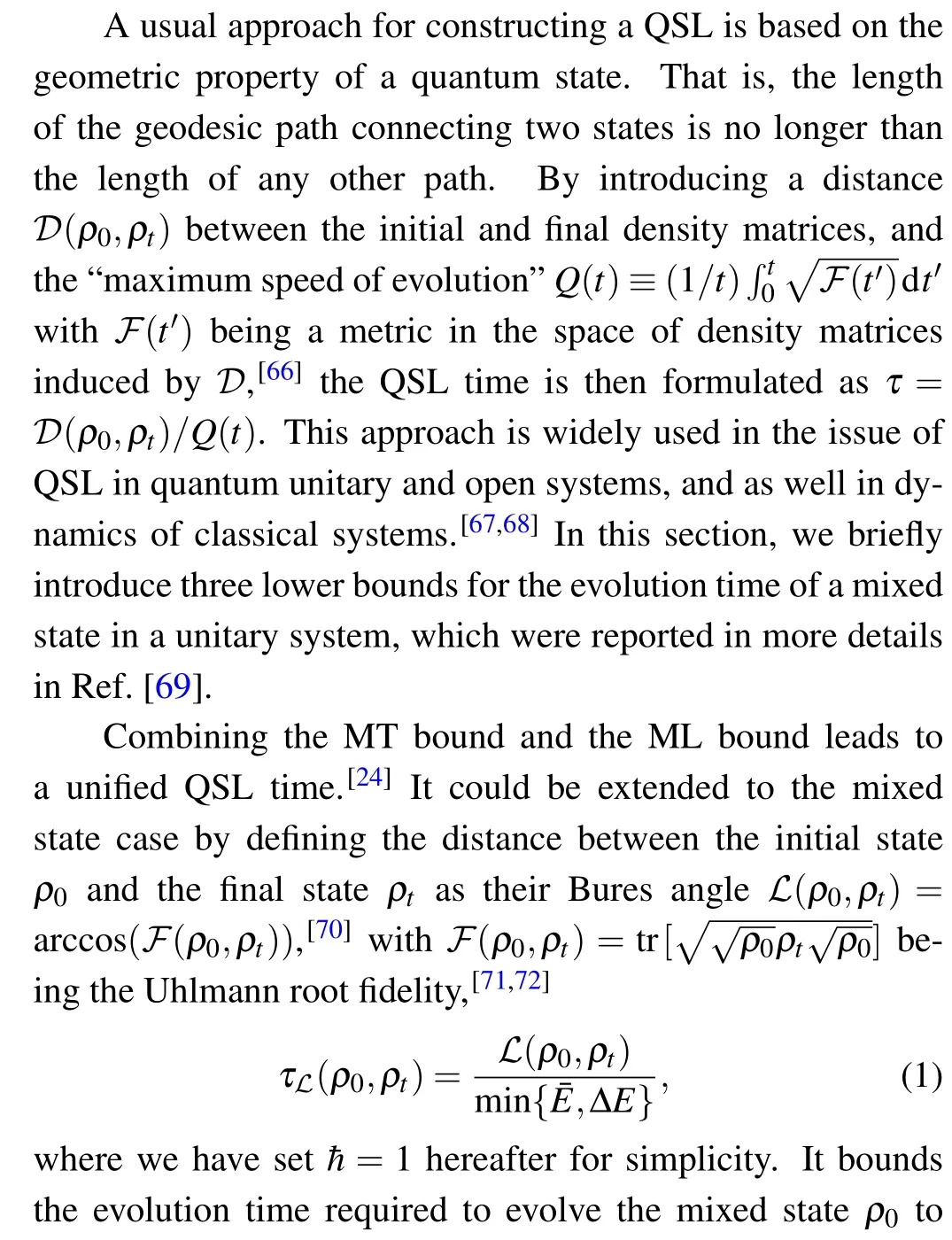
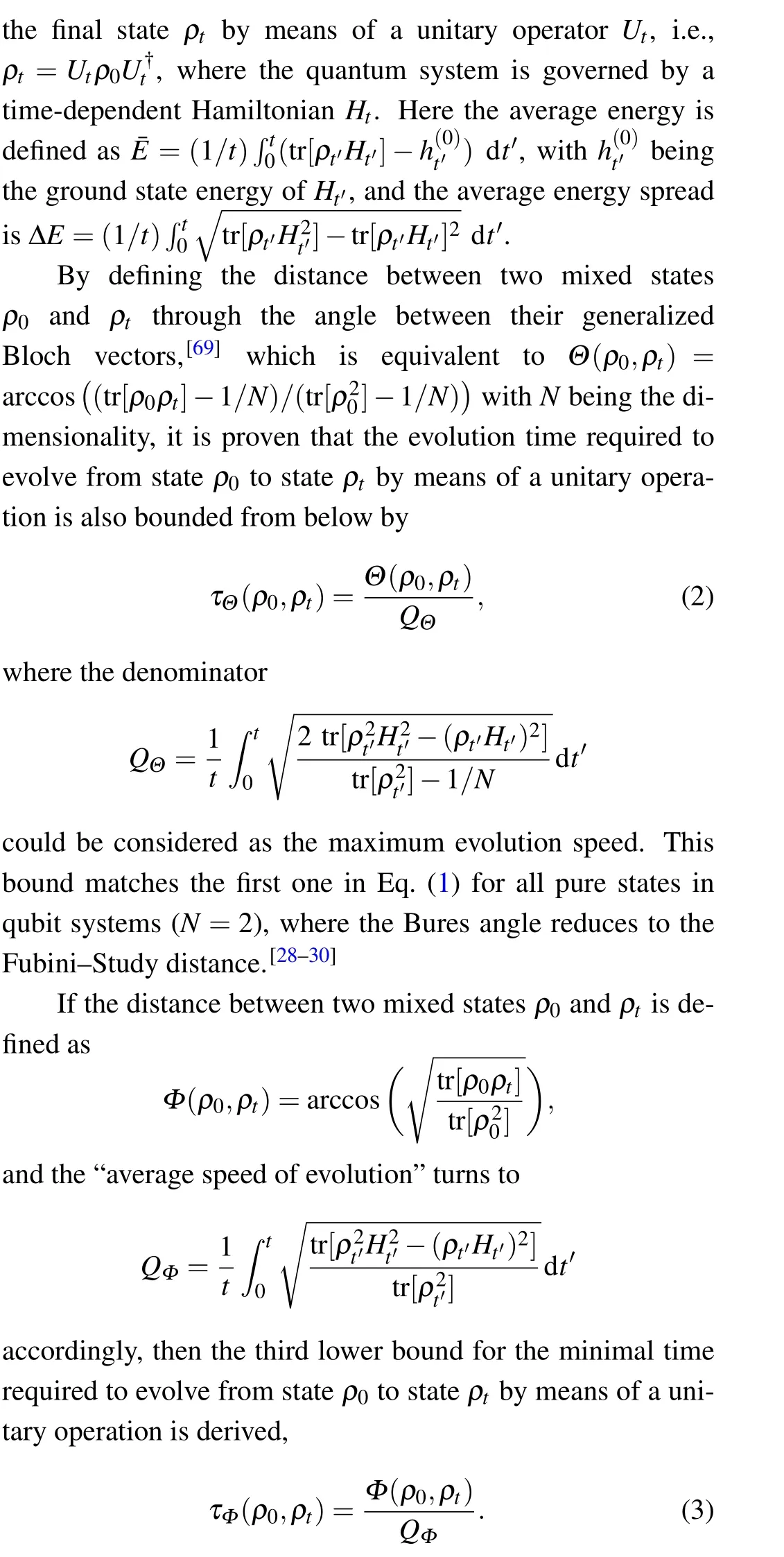
This bound matches the MT bound for pure states in all unitary systems,because the above distanceΦ(ρ0,ρt)reduces to the Fubini–Study distance in the case of pure states regardless of the dimension of the system,and the above“average speed of evolution”QΦreduces to the energy spread ΔE. It is shown that the two boundsτΘandτΦin Eqs. (2) and (3) are easy to compute and tighter than the boundτℒin Eq. (1) in most cases.[69]
3. QSL time for a mixed state
A quantum system governed by a time-dependent HamiltonianHtwould undergo a unitary evolution, and the state at
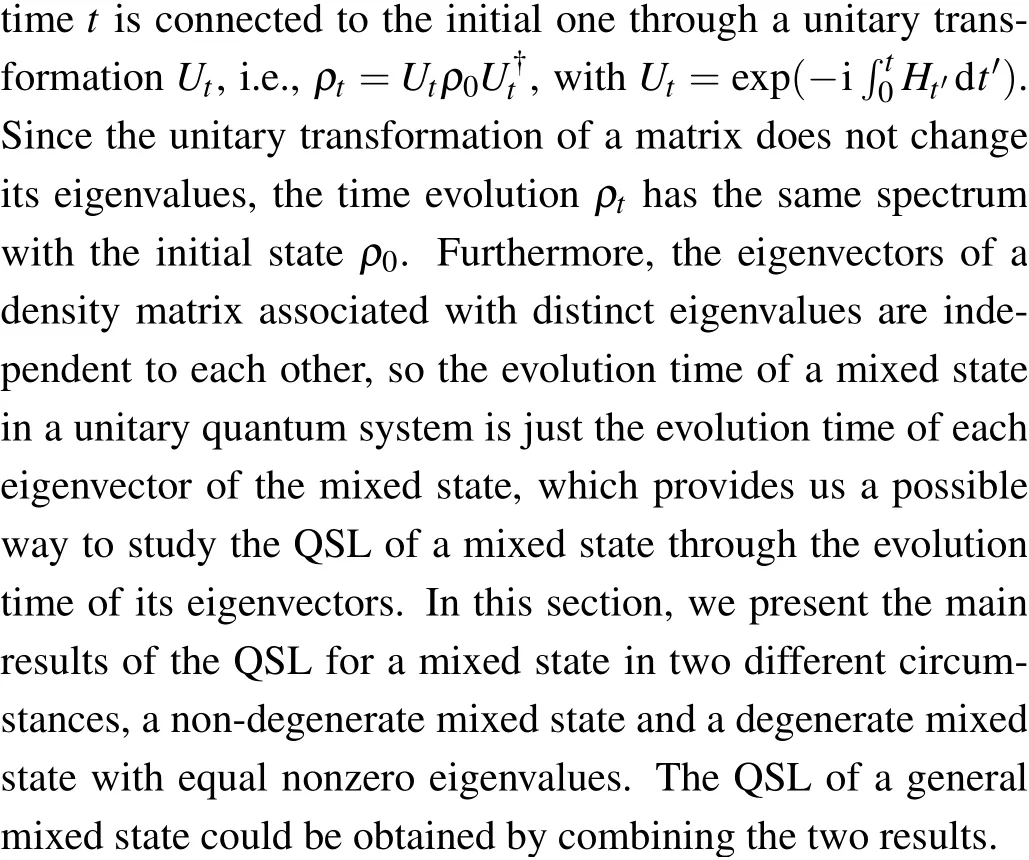
3.1. QSL time for a non-degenerate mixed state
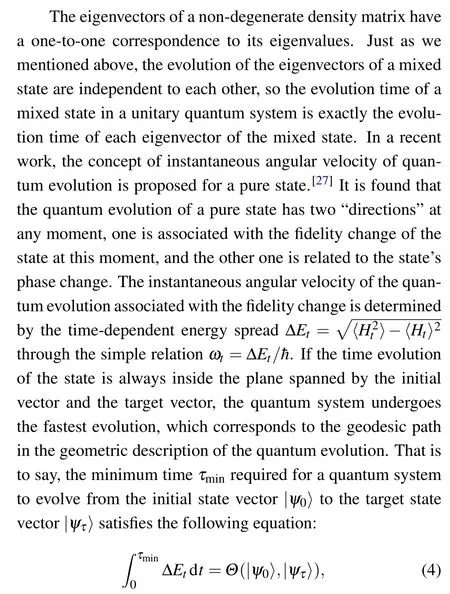
whereΘ(|ψ0〉,|ψτ〉)= arccos|〈ψ0|ψτ〉| is the Fubini–Study angle between the two state vectors|ψ0〉and|ψτ〉,and the real evolution time plays no role here. Although it is hard to work out an analytical solution forτminbased on this equation,due to the possibly irregular distribution of the energy spread ΔEtas a function of time and the integral included, its numerical result is not hard to obtain,and this equation is very useful to estimate the evolution time of a quantum system when the real evolution time is unknown to us. On the contrary, if the real evolution timeτis given, the minimum timeτminrequired to evolve between the two state vectors|ψ0〉and|ψτ〉could also be expressed as
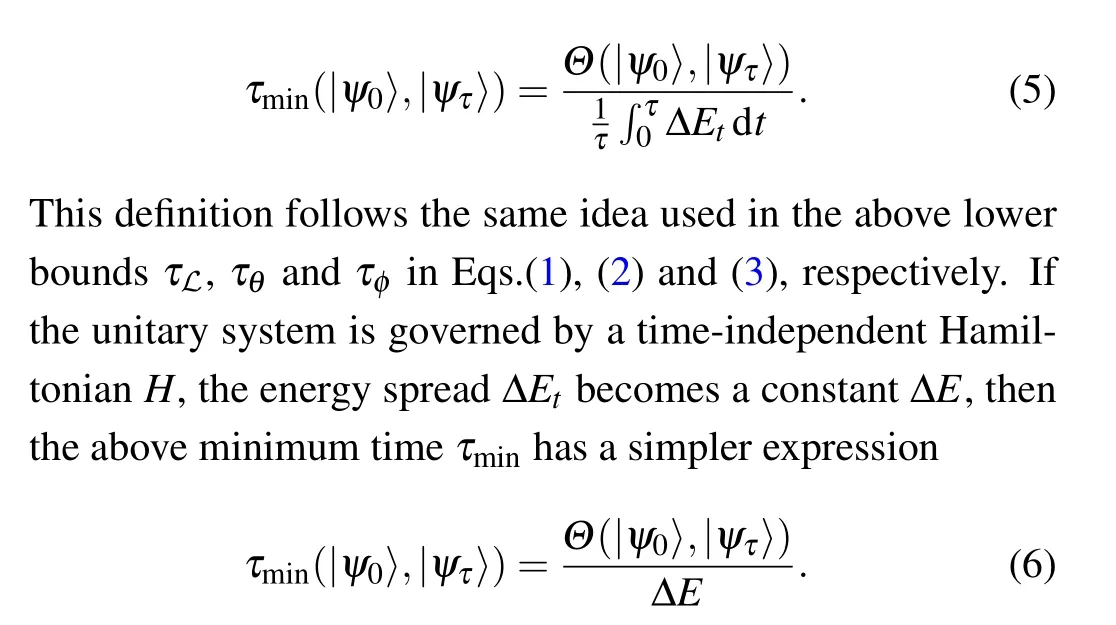
Since the Fubini–Study angleΘmeasures the geodesic “distance”between the initial state vector|ψ0〉and its time evolution|ψt〉,the minimum timeτmindefined in the above Eq.(5)or(6)is a lower bound of the real evolution time between the initial state|ψ0〉and its target state|ψτ〉.
For a mixed state without degenerate eigenvalue,the time evolution of each eigenvector brings out a minimum time according to the above Eq.(5)or(6). Noting that the evolution time of a mixed state in a unitary quantum system is exactly the evolution time of each eigenvector of the mixed state,every minimum time obtained in this way is a lower bound of the real evolution time, so the real evolution time for a nondegenerate mixed state is bounded from below by the largest one among these minimum time,
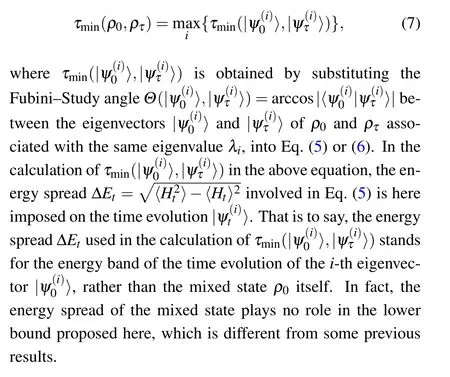
3.2. QSL time for a degenerate mixed state with equal nonzero eigenvalues
Suppose anN-dimensional quantum system is initially prepared in a degenerate mixed state whoseK(2≤K ≤N)nonzero eigenvalues are all equal toλ= 1/K. The unitary evolution of this system would keep the degeneracy of
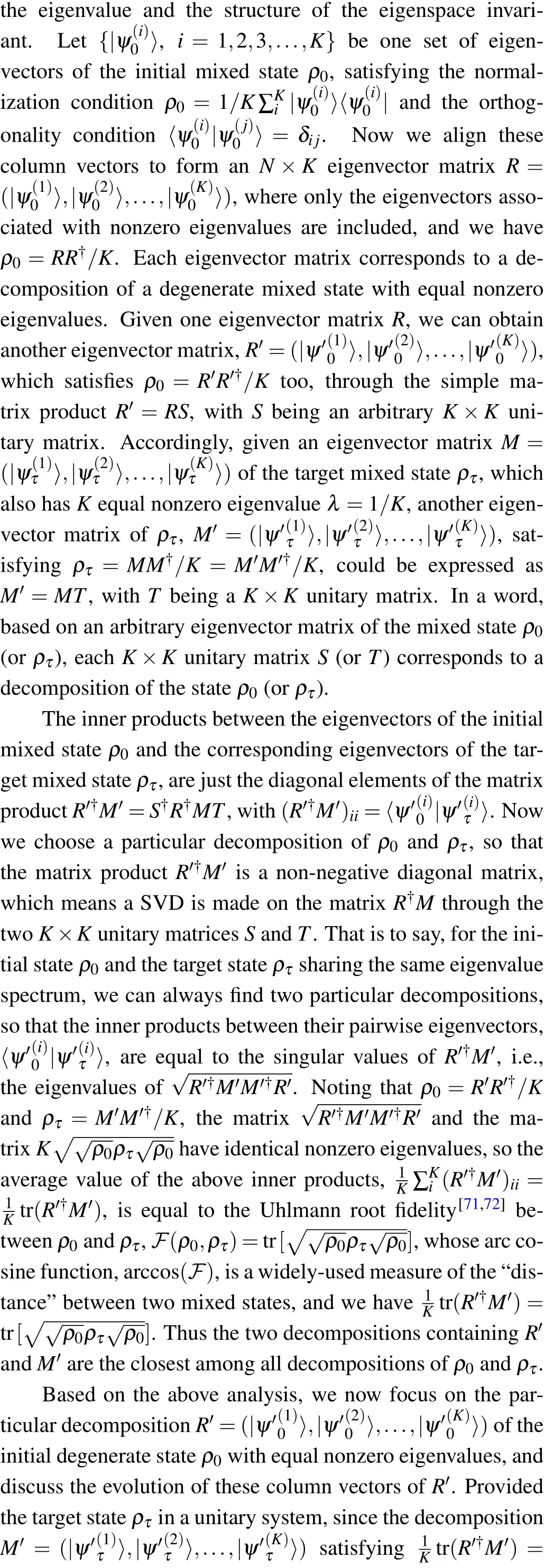
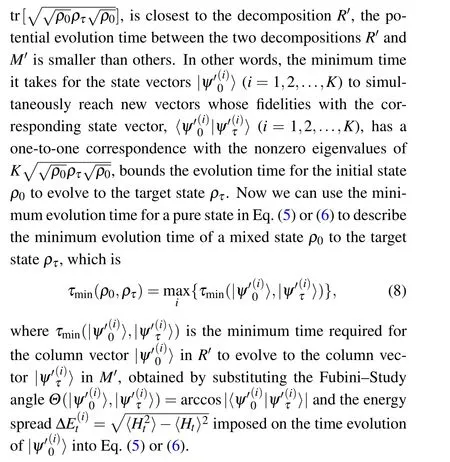
3.3. QSL time for a general mixed state
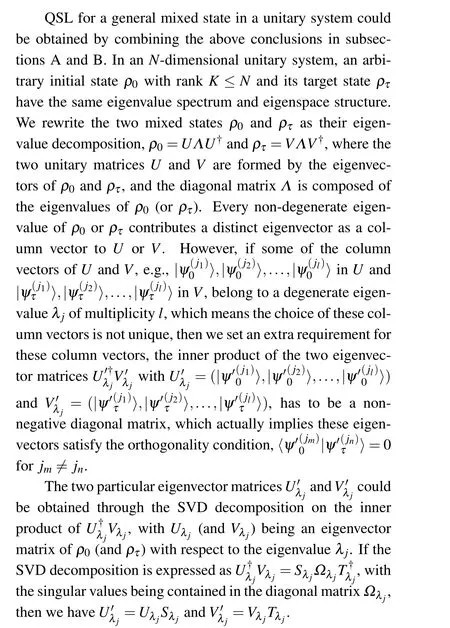

The SVD decomposition makes it more complicated to compute the QSL time of a degenerate mixed state than a non-degenerate mixed state. The lower bound for the evolution time of a mixed state proposed here is independent on the eigenvalues of the system,which is in agree with the dynamical properties of a quantum unitary system. Furthermore, it will be shown in the next section that this lower bound is very tight.
4. Results and discussion
4.1. Analytical results in a time-independent single-qubit system
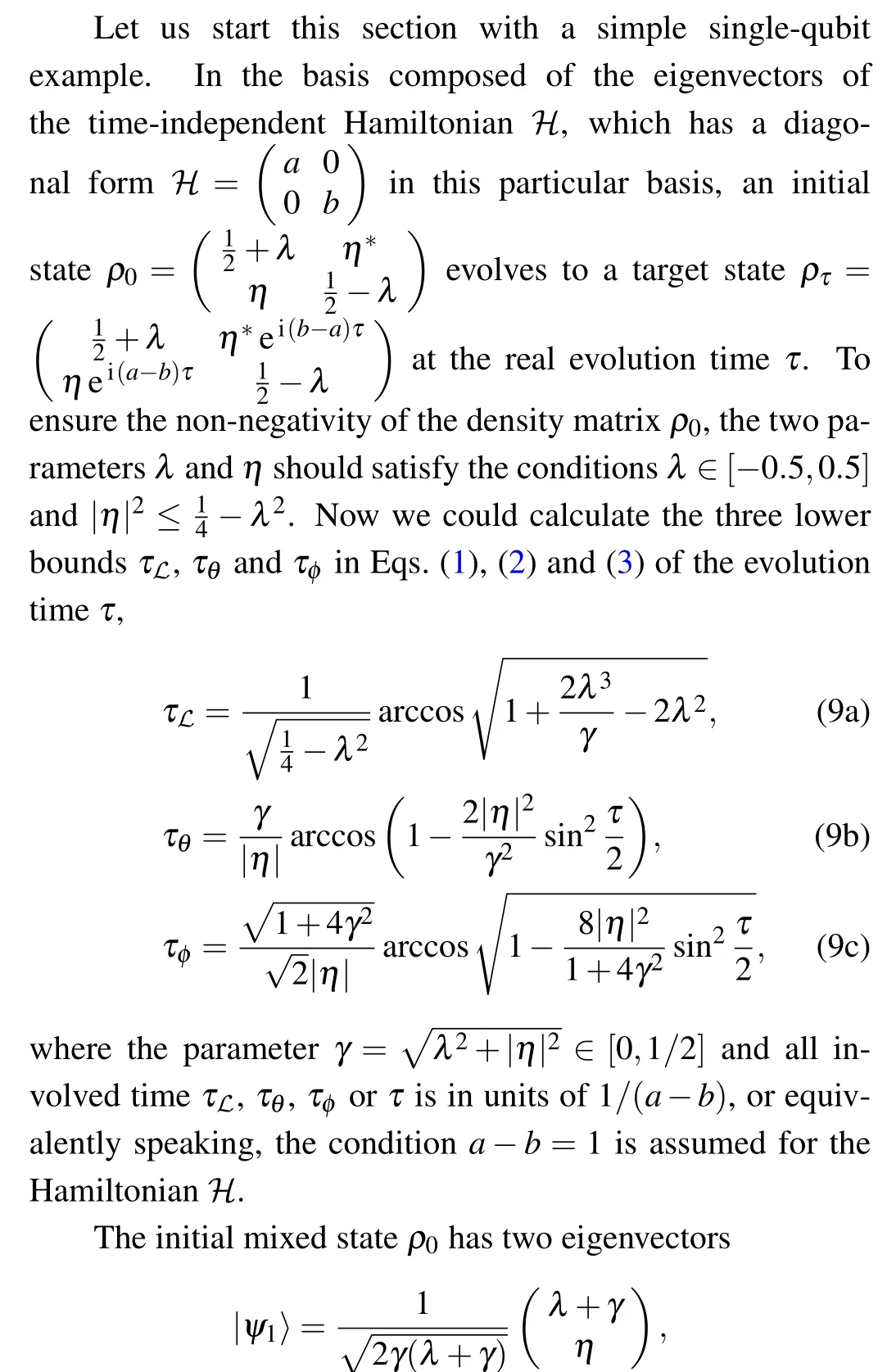
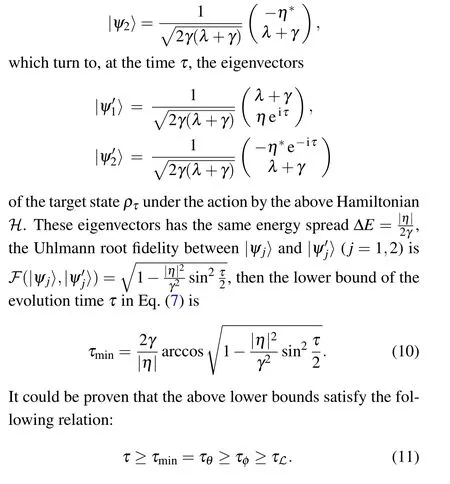
It is very interesting that the lower boundτminproposed here perfectly matches the lower boundτθin a single-qubit system,although they are defined in two completely different ways.In addition, these two lower boundsτminandτθare tighter than the other two lower boundsτφandτℒin this system.The above four lower bounds match each other for pure qubit states(γ=1/2)or mixed state without quantum coherence[73](η=0). It is found that if a mixed qubit state has no quantum coherence (η=0) in the basis composed of the eigenvectors of the time-independent Hamiltonian,it undergoes the fastest evolution, where the three lower boundsτmin,τθandτφare all equal to the real evolution timeτ,i.e.,τ=τmin=τθ=τφ.By the way, in the trivial case of maximally mixed state withλ=η=0, all the above lower boundsτℒ,τθ,τφandτminwould present a zero result,because a maximally mixed state will not change its density matrix during a unitary evolution.
4.2. Numerical results in a qutrit or higher dimensional systems
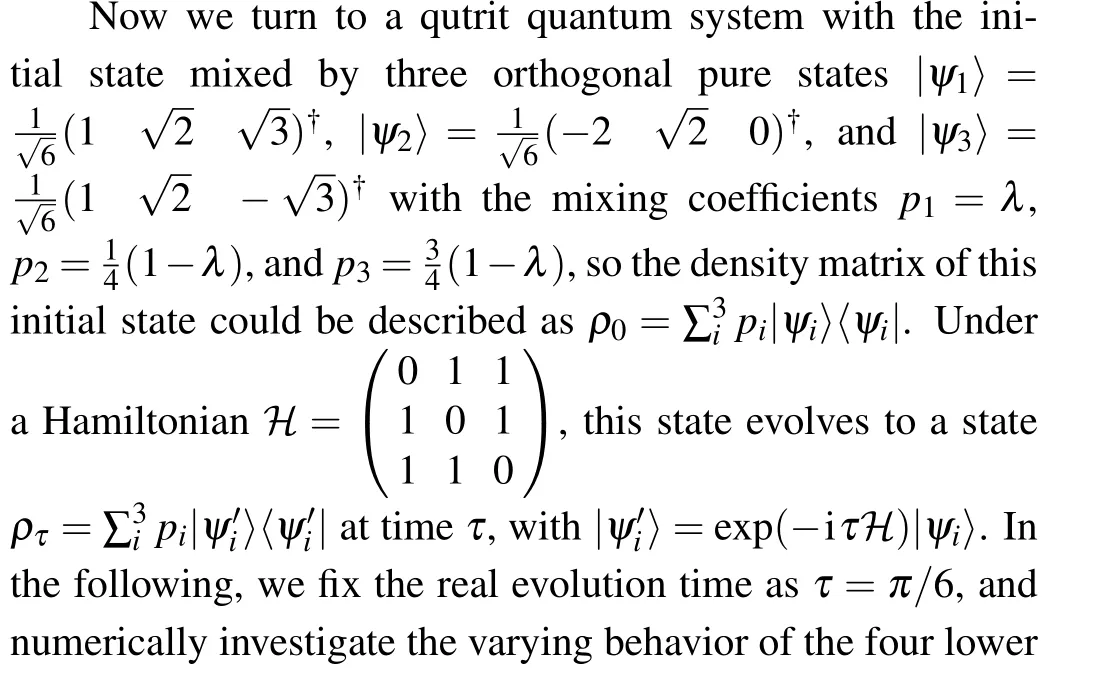


Fig. 1. Numerical results of the four lower bounds τmin, τθ, τφ, and τℒas the parameter λ changes(a). The varying behaviors of the former three lower bounds τmin,τθ and τφ are redrawn in an enlarged scale to make them clearer(b).
Different from the continuous varying behavior of the two lower boundsτθandτφwith the parameterλ,the two curves ofτminandτℒboth have two discontinuities at the pointsλ= 0.2 andλ= 3/7. See the pointsA1andA2ofτℒin Fig. 1(a) andB1andB2ofτminin Fig. 1(b), respectively, in which case the conditionp1=p2=0.2 orp1=p3=3/7 is satisfied for the mixing coefficients, and the initial stateρ0is represented by a degenerate density matrix. Here we conjecture that the two lower boundsτθandτφproposed in Ref.[69]have a continuous dependence on the initial stateρ0and the target stateρτ, may not the other two lower boundsτminandτℒ. The discontinuity might occur in the case of quantum degenerate states.
We make a numerical comparison on the tightness of the lower boundτminproposed here and the maximum one among the other three lower boundsτ′min=max[τθ,τφ,τℒ]. In a timeindependent qutrit system, we generate 106random positive matrixes as the initial mixed states throughρ0=UΛU†in a numerical program, where each unitary matrixUcontaining the eigenvectors of the mixed state is generated through a QR decomposition of a random square matrix, and the eigenvalues, contained in the diagonal matrixΛ, are also generated randomly, but the conditions of non-negativity and normalization are guaranteed. The corresponding target statesρτis generated by imposing a random Hamiltonianℋon the initial state with a randomly-chosen evolution timeτ, i.e.,ρτ= e-iτℋρ0eiτℋ. It is found that only about 4% of these sampled states have a larger lower boundτ′minthanτminfor their evolution time to evolve fromρ0to the corresponding target statesρτ. Our numerical results show that this ratio goes down to about 2%,0.9%,0.3%,and 0.1%as the dimension of the quantum system enhances from 4 to 7,where each numerical result is derived based on a sample size of 106.
Degeneracy of a density matrix may reduce the lower boundτminproposed here, according to the definition of the lower boundτminintroduced in Subsection 3.2, because the decomposition of a quantum state represented by a degenerate matrix is not unique,and we have to figure out two closest decompositions in the initial and target states to estimate the evolution time. In a time-independent qutrit system, we generate 106random positive matrixes as the initial statesρwith the eigenvaluesλ1=λ2=1/2 andλ3=0,and the eigenvectors are from the column vectors of the unitary matrix generated through the QR decomposition of a random 3×3 matrix.The corresponding target stateρτis also constructed throughρτ=e-iτℋρ0eiτℋwith randomly-chosen Hamiltonianℋand evolution timeτ. It is found that nearly half of these sampled states have a larger lower boundτ′minthanτminfor their evolution time to evolve fromρ0to the corresponding target statesρτ, and this ratio is much larger than the ratio for the nondegenerate states discussed above.Similar to the above case,this ratio becomes smaller as the dimension of the quantum system enhances. For example, in a 10-dimensional system, about 20% of the mixed states represented by a rank-deficient density matrix with equal nonzero eigenvalues have larger lower bound ofτ′minthanτmin.
5. Conclusions
In this paper, we have studied the quantum speed limits of a mixed state in a unitary system. A lower bound of the evolution time for the mixed state in a quantum unitary system is proposed based on the instantaneous angular velocity of its eigenvectors. This lower bound is independent on the eigenvalues of the mixed state, which is in accord with the properties of a quantum evolution,because unitary evolution does not change the spectrum of a quantum state, and no evidence shows that the eigenvalues of a quantum state would accelerate or decelerate the unitary evolution of a quantum state. In a single-qubit system, the lower bound proposed here is equivalent to lower boundτθproposed in Ref. [69], and they are tighter than the other two lower boundsτφandτℒintroduced in the same reference. In a qutrit or higher quantum system,our numerical results show that the lower bound proposed here is very tight. Even for degenerate quantum states, in which case the lower bound proposed here is smaller or equal to that of the non-degenerate states containing the same set of eigenvectors,more than half of these states have larger lower bound than the maximum one amongτθ,τφandτℒ.
Since the lower bound proposed here is based on the evolution time of the eigenvectors contained in the mixed state,it naturally reduces to the Mandelstam–Tamm bound in Ref.[2]for pure states of arbitrary dimension. As a price to obtain a tighter bound of the evolution time for a mixed state,the computation of the current lower bound need to make an eigenvalue decomposition of the mixed state under consideration,and even a SVD is required if a degenerate mixed state is considered, which is more complicated than the computation of the lower boundsτθ,τφ, andτℒintroduced in Ref. [69]. It is another example to demonstrate the trade-off relation between the tightness of a QSL and its computational complexity. As indicated in Eq.(8),the evolution time of a mixed state is bounded from below by the maximum evolution time of the eigenvectors, which implies that reducing the maximum evolution time of the eigenvectors may be a possible way to speed up quantum computation.
The approach developed here could not be directly used in a quantum non-unitary system, because a non-unitary dynamics would affect the spectrum of a mixed state, and the evolution of a mixed state is not equivalent to the joint evolution of the eigenvectors in this case. The generalization of the instantaneous angular velocity of a pure state to the mixed state case remains open. Furthermore, the derivation of the current lower bounds of the evolution time is mainly based on mathematical analysis on the density matrix and its unitary evolution, rather than the operational meanings of quantum evolution,and a physically meaningful QSL for open dynamics would be very interesting and remains open too at present.
Acknowledgement
Project supported by the National Natural Science Foundation of China (Grant Nos. 11664018, 12174247, and U2031145).
杂志排行
Chinese Physics B的其它文章
- A design of resonant cavity with an improved coupling-adjusting mechanism for the W-band EPR spectrometer
- Photoreflectance system based on vacuum ultraviolet laser at 177.3 nm
- Topological photonic states in gyromagnetic photonic crystals:Physics,properties,and applications
- Structure of continuous matrix product operator for transverse field Ising model: An analytic and numerical study
- Riemann–Hilbert approach and N double-pole solutions for a nonlinear Schr¨odinger-type equation
- Diffusion dynamics in branched spherical structure
